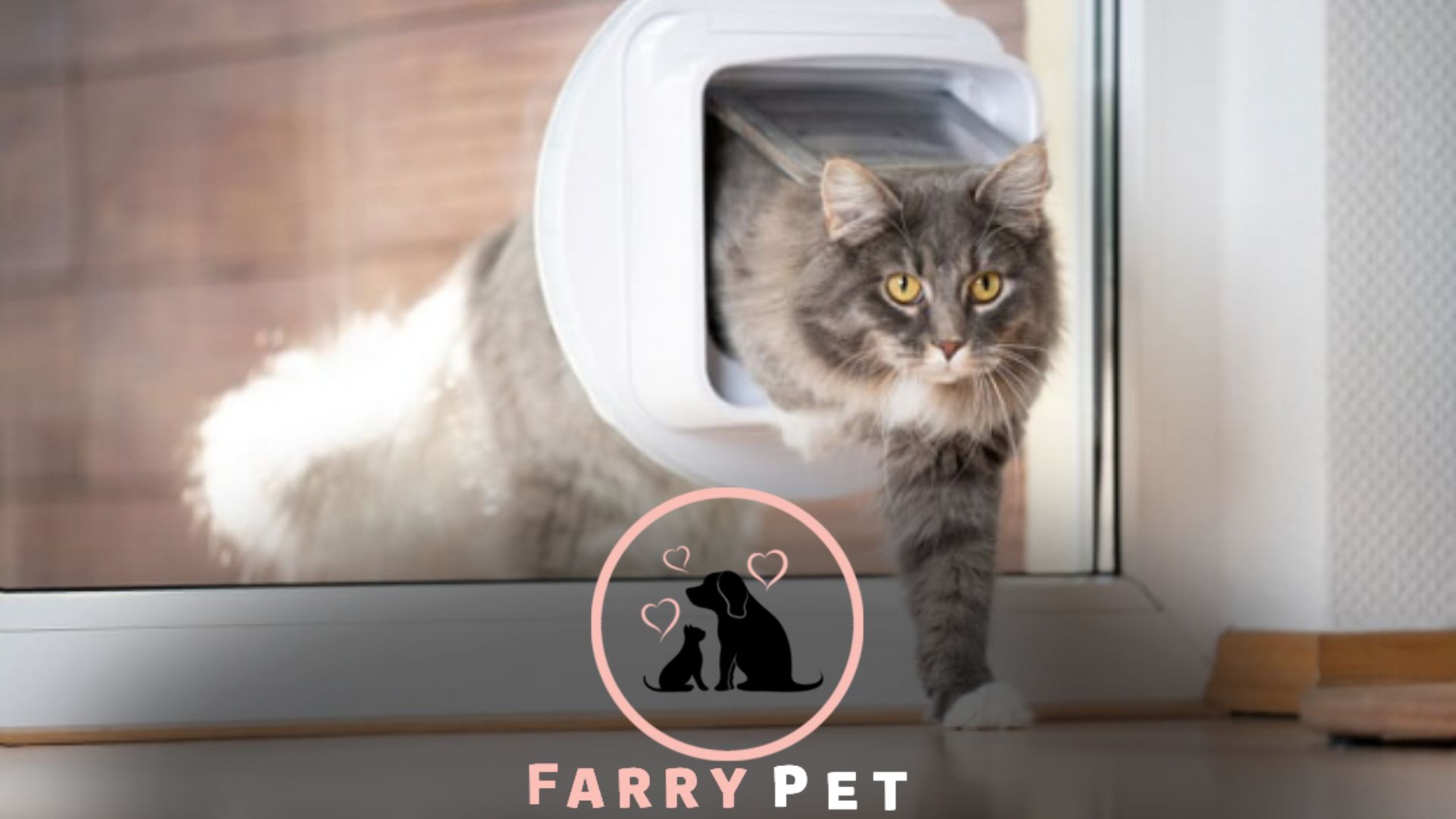
To train a cat to use a cat door, entice them with treats and toys. Gradually introduce the cat door, rewarding them each time they approach or go through it.
Establish a routine and use positive reinforcement to encourage regular use. Additionally, ensure the cat door is at an appropriate height and size for your cat.
Your cat will learn to use the cat door independently with patience and consistency.
Training cats to use a cat door can allow them to come and go as they please while keeping unwanted pests out of your home. However, teaching this behavior requires patience and consistency.
Following a few simple steps and positive reinforcement, you can successfully train your cat to use a cat door.
We will discuss the methods and techniques to train your feline friend, ensuring they understand how to navigate the cat door and use it with confidence.
With time and effort, your cat will soon be enjoying the benefits of the cat door and exploring the outdoors on their own terms. If you’re wondering about teaching your feline friend more than just using a cat door, check out our guide on Can You Teach Cats Commands? to explore the world of cat training.
The Benefits of Using a Cat Door

Using a cat door can provide cats with independence and reduce the need for constant door monitoring. This can help prevent accidents and injury, ensuring the safety of your feline friend.
Cat doors allow them to come and go as they please without needing you to open and close doors constantly.
Cats can explore the outdoors, exercise, and satisfy their natural curiosity by granting them this freedom. A cat door can also prevent unwanted behaviors such as scratching doors or meowing to be let in or out.
It is important to choose a cat door that is suitable for your cat’s size and behavior.
With proper training and guidance, your cat will quickly learn how to use the cat door and enjoy the benefits of increased independence.
Choosing the Right Cat Door
To train a cat to use a cat door, it’s crucial to choose the right one. Consider your cat’s size and needs, as this will determine their best door. Think about the location for installation, too, ensuring it’s easily accessible for your cat.
When deciding between manual and electronic cat doors, assess the pros and cons of each option. Manual doors are simple and require your cat to push through, while electronic doors offer added convenience. Make sure to gradually introduce your cat to the door, using positive reinforcement and treats.
With patience and consistency, your cat will soon be confidently using their new cat door.
Manual Cat Doors
Training a cat to use a cat door is convenient for pet owners and furry companions. Manual cat doors offer a simple installation process, making it easy for cats to understand and use them. Moreover, they are an affordable option for most cat owners.
Following a few steps, such as introducing the door gradually and using positive reinforcement, cats can quickly learn to navigate their way in and out. It is important to remember that patience and consistency are essential in this training process.
With time, cats will become comfortable using the cat door independently, providing them freedom and convenience while ensuring their safety.
So, if you’re considering installing a cat door, rest assured that with the right approach, your feline friend can quickly adapt to this new feature in your home.
Don’t forget about their agility and speed when training your cat to use a cat door. Learn how to incorporate feed the cat’s speed training into the process for a smoother transition.
Electronic Cat Doors
Electronic cat doors come with enhanced security features and programmable access control. These doors are incredibly convenient for households with multiple pets.
They allow you to train your cat to use the door and give them the freedom to come in and out as they please.
With programmable access control, you can set specific times for the door to unlock and lock, ensuring your cat’s safety. The enhanced security features provide peace of mind, keeping unwanted guests out of your home while allowing your cat the independence they desire.
So, if you want to train your cat to use a cat door, consider an electronic one with these added functionalities.
Training Your Cat to Use the Cat Door
Training your cat to use the cat door is about creating a positive association. Gradually introducing your cat to the door is crucial. Using treats and rewards helps reinforce positive behavior.
Train your cat by starting with short periods near the door and gradually increasing the duration.
It’s essential to remain patient and consistent throughout the process, providing the cat with plenty of positive reinforcement. Remember always to praise your cat when it shows interest in or approaches the door. With time and repetition, your cat will learn to associate the cat door with positive experiences and use it independently.
So, be persistent and make the training process enjoyable for your furry friend.
Curious about when to begin your cat’s training journey? Our article on what Age you should start Training Your Cat provides insights into the ideal starting age for cat training.
Familiarizing Your Cat With the Cat Door

Training a cat to use a cat door can be a gradual process. To start, place the cat door near their favorite spot. Allow them to explore and sniff the cat door at their own pace. Rewarding them using positive reinforcement when they approach the cat door is essential.
This can be done with treats or praise. Your cat will gradually become familiar with the cat door by associating it with positive experiences.
Remember to be patient and give your cat time to adjust. Each cat is unique and may require different amounts of time to feel comfortable using the cat door.
With persistence and positive reinforcement, your cat will soon confidently use the cat door.
Encouraging Your Cat to Approach and Pass Through the Cat Door
Train your cat to use a cat door by holding it open and guiding them through. Use treats to entice them to pass through on their own. Gradually increase the time the door remains closed. Practice patience and consistency during this process.
Allow your cat to explore and become comfortable with the cat door at their own pace. Reward them with praise and treats when they successfully pass through.
Keep the training sessions short and positive, avoiding any negative reinforcement. With time and practice, your cat will confidently approach and pass through the cat door independently.
Remember to be patient and reinforce positive behaviors throughout the training process.
Is your cat a bit older? No worries! Discover in our post, Can You Still Train a 1-Year-Old Cat, how you can successfully train a cat to use a cat door even if they’re a year old.
Gradually Introducing Independent Use
To train your cat to use a cat door, it is essential to introduce independent use gradually. Start by closing the door behind your cat and monitor their progress.
Encourage them as they become more comfortable. With time, decrease supervision and allow them to use the door independently.
Troubleshooting Common Challenges
Common troubleshooting challenges may exist when training a cat to use a cat door. One of these challenges is fear or hesitation. Some cats may fear the cat door and refuse to use it.
To address this, you can start by gradually introducing the cat to the door, allowing them time to approach it at their own pace.
Another challenge is getting stuck or feeling trapped. This can happen if the cat is unsure how to navigate the door. You can use positive reinforcement techniques to help the cat overcome this, such as rewarding them with treats or praise when they successfully use the door.
You can confidently train your cat to use the cat door by addressing these challenges.
Fear or Hesitation
Training a cat to use a cat door may initially be met with fear or hesitation. However, with patience and positive reinforcement, progress can be made.
Start by slowly increasing exposure and familiarity with the cat door, rewarding the cat for any steps towards using it.
It’s essential to consult with a feline behavior specialist if needed, as they can provide expert guidance tailored to your cat’s specific needs.
Following these steps, you can help your cat overcome fears or hesitations and successfully train them to use a cat door.
Refusal to Use the Cat Door
Training a stubborn cat to use a cat door can be challenging. If your cat refuses to use the cat door, you may need to revisit the training steps. Try making the cat door more appealing by using treats or toys as incentives.
Sometimes, professional guidance may be necessary if the issues persist. Remember to be patient and consistent in your training efforts. With time and perseverance, your cat may eventually learn to use the cat door independently.
Getting Stuck or Feeling Trapped
Getting your cat to use a cat door can be a challenge. One common issue is when your cat gets stuck or trapped while using the door. To prevent this, ensure the cat door is the right size for your cat.
Regularly clean and maintain the door to ensure smooth operation. Additionally, consider providing your cat with alternative access options or escape routes. This will give your cat a sense of security and freedom when using the cat door.
By following these steps, you can successfully train your cat to use the cat door without any issues or feelings of being trapped.
Frequently Asked Questions
How Long Does It Take a Cat to Learn a Cat Door?
A cat typically takes a few days to a couple of weeks to learn how to use a cat door. Training involves introducing the cat to the door and enticing them with treats or toys to encourage them to walk through.
Providing positive reinforcement and patience are key components of the training process. It is important to give the cat enough time to become comfortable and familiar with the door before expecting them to use it independently.
Each cat is unique, so the timeline for learning may vary.
How Do I Teach My Cat to Use a Cat Door?
Teaching your cat to use a cat door is a gradual process that requires patience and positive reinforcement. Start by propping the door open and enticing your cat with treats and toys to get her comfortable in the doorway.
Gradually lower the door until it is fully closed, rewarding your cat each time she goes through successfully.
If your cat hesitates, try using a soft, flexible door or removing the flap altogether. Encourage your cat to use the door by placing treats or food on the other side.
It may take some time for your cat to become accustomed to using the cat door, so be patient and consistent with your training.
Avoid forcing or scaring your cat in any way, as this can create negative associations with the door.
Should I Leave My Cat Flap Open At Night?
Leaving your cat flap open at night is a personal choice. Some owners prefer to leave it open to allow their cats to come and go. It allows them to access the outdoors and engage in their natural hunting instincts.
However, there are some potential risks to consider. Leaving the cat flap open could invite other animals into your home or allow your cat to roam too far. It may also attract unwanted pests.
Additionally, there are safety concerns, as your cat could wander into dangerous situations or encounter other territorial cats.
To ensure your cat’s safety, consider installing a microchip cat flap that only allows your cat to enter. Alternatively, you can keep the cat flap closed at night and provide your cat with a comfortable indoor space.
Ultimately, the decision depends on your location, your cat’s personality, and your concerns for their safety.
Can Cats Be Trained to Open Doors?
Yes, cats can be trained to open doors. It requires patience, consistency, and positive reinforcement. Start by teaching your cat to respond to a command, such as “door. ” Reward them with treats or praise every time they answer correctly.
Next, show your cat how to interact with the door, using your hand to demonstrate how to push or pull it. Gradually guide their paw or noses towards the door handle. Once they start using their paw or nose on the handle, reward them generously.
Practice regularly, gradually reducing your assistance until your cat can open the door independently. It’s essential to ensure that the doors in your home are safe for your cat to interact with without risk of injury.
Not all cats will master this skill, depending on their temperament and motivation.
How Do You Train a Cat to Use a Cat Door?
Training a cat to use a cat door is a gradual process that involves rewards, patience, and positive reinforcement.
Conclusion
Training a cat to use a cat door is rewarding and practical. Following the steps outlined in this blog post can ensure a smooth transition for your feline friend. Patience, positive reinforcement, and consistency are key when teaching your cat this new skill.
Remember to start slow and gradually increase their exposure to the cat door. Don’t forget to praise and reward your cat for their successes. With time and effort, your cat will become comfortable and confident using the cat door independently.
This newfound freedom will benefit your cat and provide convenience and peace of mind.
So why wait? Start the training process today and enjoy the convenience of a cat door in your home.



![Can You Still Train a 1-Year-Old Cat? [Possibility Study]](https://farrypet.com/wp-content/uploads/2023/08/Packing-Tips-for-Moving-65-768x432.jpg)


